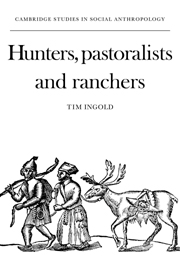Book contents
- Frontmatter
- Contents
- List of figures and tables
- Preface
- Prologue: On reindeer and men
- 1 Predation and protection
- 2 Taming, herding and breeding
- 3 Modes of production (1): hunting to pastoralism
- 4 Modes of production (2): pastoralism to ranching
- Epilogue: On band organization, leadership and ideology
- Locations of circumboreal peoples
- Appendix: The names and locations of circumboreal peoples
- Notes
- Bibliography
- Author index
- Subject index
Epilogue: On band organization, leadership and ideology
Published online by Cambridge University Press: 12 September 2009
- Frontmatter
- Contents
- List of figures and tables
- Preface
- Prologue: On reindeer and men
- 1 Predation and protection
- 2 Taming, herding and breeding
- 3 Modes of production (1): hunting to pastoralism
- 4 Modes of production (2): pastoralism to ranching
- Epilogue: On band organization, leadership and ideology
- Locations of circumboreal peoples
- Appendix: The names and locations of circumboreal peoples
- Notes
- Bibliography
- Author index
- Subject index
Summary
This study already incorporates more conclusions than either its evidence or its arguments will support, and I must beg the reader's indulgence for appending some further thoughts and speculations which, as the saying goes, ‘call for further research’. These concern, in particular, the superstructural correlates of transformations between hunting, pastoralism and ranching. They are of three kinds: organizational, political and ideological. We have first to deal with that elusive and apparently indefinable entity, the ‘band’. What form does it take in reindeer-hunting societies, and how might its size, permanence and composition be affected by the transition to pastoralism? Secondly, we have to consider the nature and scope of leadership in reindeer-exploiting societies, and its relation to the possession or distribution of wealth. Our third problem is to account for the focus, in the ideologies of hunters, pastoralists and ranchers, on the individual as the autonomous bearer of particular qualities – physical, intellectual and mystical. Finally, I shall speculate on the manner in which the transfer of control over animals from nature to man affects conceptions of, and relations with, the supernatural.
Let us begin, then, with the band. We must, at the outset, beware of becoming ensnared in a fruitless search for the diagnostic characteristics of the ‘band level’ of social integration. Some writers have extended the concept to include any nomadic or semi-nomadic communities, be they of hunters and gatherers or pastoralists (Murdock 1949:80, Steward 1969).
- Type
- Chapter
- Information
- Hunters, Pastoralists and RanchersReindeer Economies and their Transformations, pp. 264 - 285Publisher: Cambridge University PressPrint publication year: 1980



